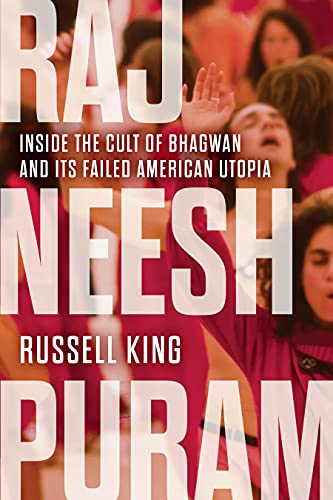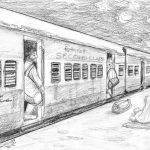Subhuti’s words after reading Russell King’s Rajneeshpuram: Inside the Cult of Bhagwan and Its Failed American Utopia.
 Rajneeshpuram:
Rajneeshpuram:
Inside the Cult of Bhagwan and Its Failed American Utopia
by Russell King
Chicago Review Press (8 March 2022)
348 pages
Hardcover and Kindle
Stop right there! Yes there, at the very beginning. Because, from the very beginning, the author has got it wrong. He says, in his introduction: “At its heart, this book is about the attraction to power in all its beguiling forms and how every utopia finds its victims.”
That may be what his book is about. But it is not what Rajneeshpuram was about. Not for me and not for 99 percent of the people who lived there.
This well-intentioned author, an American investigative journalist, has been watching too many news clips about Donald Trump and Vladimir Putin. Politics, as usual, is allowed to take centre stage, while the real story – also as usual – remains within the enigmatic realm of silence. And so, if you groan and murmur, “Oh no! Not another ‘what-went-wrong’ book about the Oregon experiment,” I can certainly sympathize with you.
But wait. Maybe I can help. If it’s too much for you to manage to read as far as the author’s introductory notes, don’t worry. We need not proceed even beyond the book’s title:
Rajneeshpuram: Inside the Cult of Bhagwan and its Failed American Utopia. The very idea that Rajneeshpuram failed shows the author’s superficial approach. On what grounds does this hack writer make this assumption? Well, rather like our old Oregon neighbours, the worthy citizens of Antelope, he’s probably scratching his head and saying: “Well, gee, folks, ain’t it obvious? They came, they built a town in four years, it suddenly fell apart. That’s failure, innit?”
This dumb pen-pusher is peering into a parallel universe, seeing through glasses coloured by his own journalistic attitudes, not knowing that concepts like success and failure don’t apply.
He’s like an atomic scientist, observing the quarks and neutrinos shooting around inside a particle accelerator, but missing the dark matter sustaining it all. His idea of dark matter is listing crimes. My idea of dark matter is the nature of consciousness.
And come to think of it, that’s not a bad analogy for Rajneeshpuram: a particle accelerator that got everyone spinning faster and faster and faster…in the hope that some of us might make the quantum leap to the centre of the cyclone (if you’ll pardon my mixed metaphors).
By the way, proceeding no further than the book’s title, one cannot help noticing his use of that tired buzzword: “cult.”
Here, again, we find ourselves in the shallow realms of superficiality, as if seeking pearls of wisdom in Mickey Mouse cartoons, so to speak.
Because, yes, on that outer layer, we seemed to be members of a cult. Yes, a bunch of people wore the same-coloured clothes, with the same wooden beads around their necks, hugged each other, meditated, celebrated, and had fun doing a whole bunch of stuff together. Oh yes, and, by the by, built a town in Oregon.
Yet even on this superficial level, our author gets it wrong. Even in the title! He talks about our “American Utopia.”
Allow me to point out a few paradoxes:
A spiritual leader who really wanted his disciples to create Utopia in Oregon would be foolish to do any of the following, let alone all of them:
Provoking the locals by taking over their town.
Collecting 93 Rolls Royces as a spoof on American consumerism.
Telling his secretary to use four-letter words on TV.
Calling America “a hypocrisy not a democracy.”
Dismissing the American President as a “third rate cowboy actor” (sorry, Ron, but it’s true).
And he certainly would not say, as Osho did, after three years in Oregon, “Okay, Sheela, now I want to go back to India.”
Utopia? Gimme a break. It was a pressure cooker with the safety valve sealed shut, heated by flames of controversy… and guaranteed to explode.
So, what about the enigmatic ‘dark matter’ at the heart of our story, which this academic fails to notice or address?
Forgive me, but here I need to get personal: Once upon a time, a long time ago, I went looking for Truth. I suspected it was inside me, but I needed more proof. I met a man who had disappeared into the Big Zero and in his presence, I tasted that Emptiness within myself. I became his sannyasin, giving him permission to work on me, one-on-one. It was a unique, invisible connection.
Just like everyone else who showed up at his door, I embraced the mystery of the Master-Disciple relationship: the non-relationship of two Zeroes meeting and merging. There was nobody home. Therefore, there was no cult. There was no Utopia. There was no failure.
On the contrary, the death of Rajneeshpuram was a liberation for me and I simply loved going back to India.
One more thing: after making the predictable and age-old mistake of confusing enlightened consciousness with moral behaviour, the author portrays Osho as a charlatan.
The only glimmer of intelligence in his whole book comes at the end, when a sannyasin is quoted as saying that he dislikes categorizing Osho as either a demon or a saint.
“Why can’t they both be true?” asks the sannyasin.
To which I would add: “Both true…and beyond both.”
So, my friends, sorry to say, there is nothing new in this mundane book, which is basically a written-down version of the Netflix six-part documentary that covered the same story.
17.7.2022: minor edits done to the text





Comments are closed.